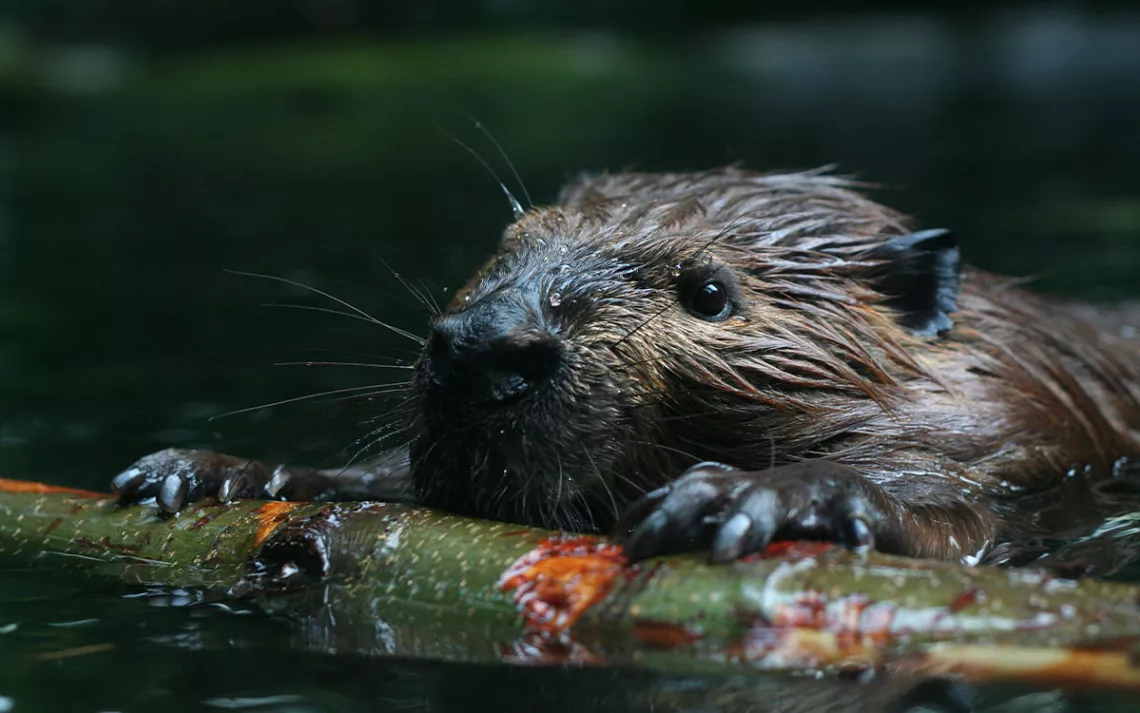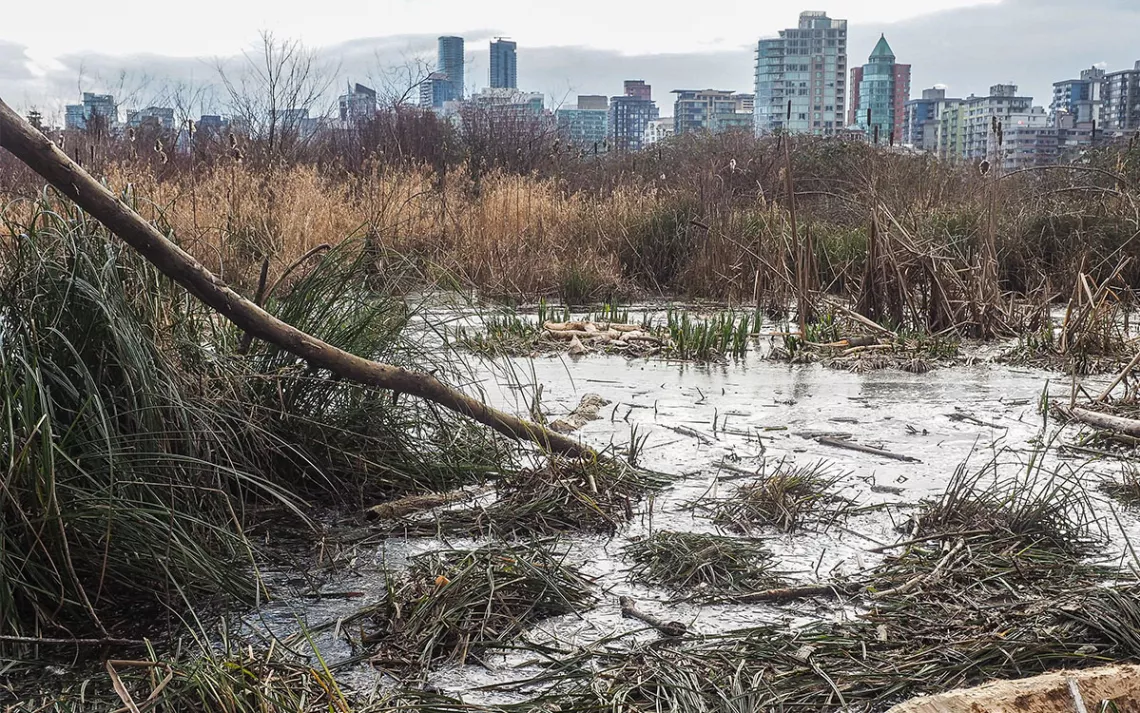How to Baffle a Beaver
A simple trick turns destructive urban pests into valuable ecosystem engineers

Photo by jeffhochstrasser/iStock
When the first beaver returned to Stanley Park's Beaver Lake in Vancouver after a 60-year absence, no one knew where it came from. Some thought it had followed streams in from the Fraser Valley. Others suggested it had dodged freighters and fought Burrard Inlet’s strong currents, swimming from North Vancouver’s Capilano watershed. But far from being thrilled with the return of the lake’s namesake, park officials at the 1,001-acre, forested jewel were dismayed. In cities all over North America—New York, Seattle, Montreal, and others—the return of the aquatic rodents had wreaked havoc on landscapes as they toppled trees, flooded trails and roads, and damaged infrastructure.
Many cities’ initial solution was to trap the pioneering beavers and remove their dam debris. But wildlife managers discovered that beavers are persistent; despite dismantled dams and trapped beavers, new animals just kept showing up. Then, like the person who built a better mousetrap, a guy came up with a way to baffle the beavers into better behavior—which not only led to a truce, but also a healthier ecosystem.

Signs of beavers are seen in Vancouver’s Lost Lagoon in winter. | Photo by Diane Selkirk
Beavers have been a part of the North American landscape for 24 million years, evolving from bear-size rodents into their current, much cuter form. Indigenous communities coexisted with a population ranging from 60 to 400 million animals; utilizing them for meat, fur, and castoreum, a sweet-smelling gland excretion used in traditional medicines and—eventually—vanilla ice cream. But it was their fur—with 75,000 to 150,000 hairs per square inch—that nearly led to their downfall. Demand for the warm, waterproof pelts drove much of European exploration and colonization of North America. By the time beaver hats fell out of fashion, only remote pockets of the animals remained.
Beaver pairs, which mate for life, produce one or two pups a year. When pups reach maturity at around two years, they strike out on their own, traveling an average of 3.5 miles in search of new terrain. Over time, the beavers began to rebound, returning to their historical habitat—much of which included cities.
It was one of these returnees I came to Stanley Park hoping to see. I followed the advice of Marisa Bischoff, a conservation technician with the Stanley Park Ecology Society (SPES), who suggested I visit the park at dusk when the crepuscular creatures are busiest. Despite the hum of adjacent roads, the park’s beaver population has grown to two family colonies of four to six each. In Vancouver overall, approximately 45 beavers now live in nine or more active lodge sites across the city.
Bischoff explained that part of beavers’ success in adapting to urban areas lies in the fact that as ecosystem engineers, they’re biologically programmed to alter imperfect environments to better suit their needs. “By building dams, they increase the depth, area, and perimeter of a wetland,” said Bischoff—as well as providing protection from predators and winter cold.
It turns out these dam-building actions also help the environment. They recharge groundwater, filter out sediments, and create habitat for waterfowl, amphibians, fish, and aquatic invertebrates—all while providing ecological services including flood control, drought management, and carbon sequestration.
The problem Stanley Park staff had to solve was how to reap these benefits without turning the popular park into a treeless wetland. "We have a choice with nature,” said Christopher Stinson, lead curatorial assistant of mammals, reptiles, and amphibians at the Beaty Biodiversity Museum. “We can constantly fight it—in the case of beavers this means we kill them and dig out their dams and call it pest management. Or we can learn to work with nature and create better functioning ecosystems."
Beavers build dams instinctively in order to stop the sound of running water. This innate quirk was key to a solution that lets beavers build dams in a nondetrimental way. Dreamed up by a man named Skip Lisle, flow devices—with catchy trademarked names like Beaver Baffler, Castor Master, and Beaver Deceiver—trick the beaver into thinking they’ve built the perfect dam by eliminating the noise and sensation of flowing water.
Typically a two-part system, bafflers use a long perforated pipe to divert water from the center of a pond out through a hole in the dam and down into the stream. The pipe helps muffle the sound of running water until it’s past the dam, and exclusion fencing on each end of the pipe keeps the beaver from plugging the system. While the flow device requires maintenance (debris needs to be regularly removed from the fencing), water (and fish) can flow through. The beaver can’t figure out how, or why—so they just keep patching their dam while humans control the water level of the wetland.
Continuing around the lake, I almost pass one of these simple looking devices without noticing it. In the years since the Vancouver Park Board installed its first baffler in 2009, park staff has become more adept at coexisting with beavers. One technique includes wrapping wire around the base of the most valuable trees (beavers can cut down up to 216 trees per year, favoring aspen and willow). Then they added or reconfigured four more bafflers between 2014 and 2015. Most recently, in 2020, they introduced a new, sturdier baffler in Beaver Lake—this one includes a fish ladder to accommodate newly returning salmon, a solution that once wasn’t thought possible.
Other communities have also begun to realize the advantages of having beavers in the hood. In Seattle, which hosts more than a dozen colonies, beavers made an unexpected appearance in Golden Gardens Park’s man-made lagoon in 2015. Their presence enhanced the biodiversity of the simple pond system, which was originally designed to filter storm runoff from a parking lot. In Thornton Creek, a waterway draining an 11.6-square-mile urban watershed, the return of beavers was planned for. Dams now play a crucial role in restoring wetland biodiversity, slowing fast-moving stormwater, mitigating flooding, and alleviating drought conditions.
Back at Lost Lagoon, I kept scanning for beavers but only spotted a few raccoons and a playful group of river otters darting in and out of Ceperley Meadows. Where some of the lagoon’s shoreline was once a sterile lawn, it’s now a wetland crossed with toppled trees and filled with marsh grasses and bulrushes. Stinson, who guides SPES’s Beavers and Beverages walks in the park, tells me this newly diverse, rewilded landscape is much better equipped to withstand climate change than it previously was. As the stars come out, I realize this flourishing urban wilderness—wild enough to be able to conceal an entire colony of beavers—is part of what’s making our shared city a more resilient place.
 The Magazine of The Sierra Club
The Magazine of The Sierra Club



